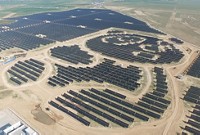Advertisement
Grab your lab coat. Let's get started
Welcome!
Welcome!
Create an account below to get 6 C&EN articles per month, receive newsletters and more - all free.
It seems this is your first time logging in online. Please enter the following information to continue.
As an ACS member you automatically get access to this site. All we need is few more details to create your reading experience.
Not you? Sign in with a different account.
Not you? Sign in with a different account.
ERROR 1
ERROR 1
ERROR 2
ERROR 2
ERROR 2
ERROR 2
ERROR 2
Password and Confirm password must match.
If you have an ACS member number, please enter it here so we can link this account to your membership. (optional)
ERROR 2
ACS values your privacy. By submitting your information, you are gaining access to C&EN and subscribing to our weekly newsletter. We use the information you provide to make your reading experience better, and we will never sell your data to third party members.
Materials
Shortages Loom For Electronic Materials
Japanese Disaster: Factories making key electronic raw materials cannot restart immediately
by Jean-François Tremblay
March 23, 2011

Several plants making key chemicals used in electronics manufacturing have yet to restart following the earthquake and tsunami that devastated northern Japan on March 11. If these facilities do not restart soon, global output of computer chips and liquid crystal displays could be affected, electronics consultants warn.
A Mitsubishi Gas Chemical plant in Fukushima prefecture producing most of the world's supply of bismaleimide triazine resin is knocked out, and it's not clear when operations will resume, the company says. The material is used to make printed circuit boards for mobile phones.
Also out of commission are two facilities that together represent a quarter of the world's capacity for silicon wafers, the base material for semiconductor fabrication. Shin-Etsu Chemical says it doesn't know when it will be able to restart its Shirakawa facility in Fukushima prefecture, home to Japan's damaged nuclear reactors. The giant plant can produce about 20% of the world's wafers. Missouri-headquartered MEMC has suspended operations until further notice at its Utsonomiya wafer plant, about 60 miles north of Tokyo.
Production of liquid crystal displays is likely to be disrupted by the Japanese quake, according to the Taipei-based market research firm DisplaySearch. In a research note, the firm observes that three Japanese companies--Mitsui Chemicals, Kanto Denka Kogyo, and Central Glass--account for roughly 30% of the world output of nitrogen trifluoride, a cleaning gas used in display manufacturing. Japanese production of the gas, already in tight supply before the quake, could be disrupted by irregular electricity output in Japan and by damage to a Kanto Denka plant, according to DisplaySearch.
Similarly, DisplaySearch notes that indium tin oxide, a transparent conductor used in liquid crystal displays, is mostly made in Japan. The world's largest producer, JX Nikko, has stopped production at a plant located 50 miles from the troubled Fukushima nuclear reactors, DisplaySearch says.
Despite the production problems, it's too early to conclude that the world's electronics industry will be severely affected by the quake. "It's a very chaotic situation right now," cautions David Hsieh, DisplaySearch vice-president for the China region. Most display manufacturers maintain some inventory of key components, he says. "It would be irresponsible right now to say that there are actual shortages developing."
Two major semiconductor producers, Qualcomm and Taiwan Semiconductor Manufacturing Co., say they have no indications that their operations will be disrupted. Qualcomm says it will make use of existing inventories of bismaleimide triazine resin and start to rely on alternate producers. The firm insists that its supply chain can deal with any single supplier outage.



Join the conversation
Contact the reporter
Submit a Letter to the Editor for publication
Engage with us on Twitter